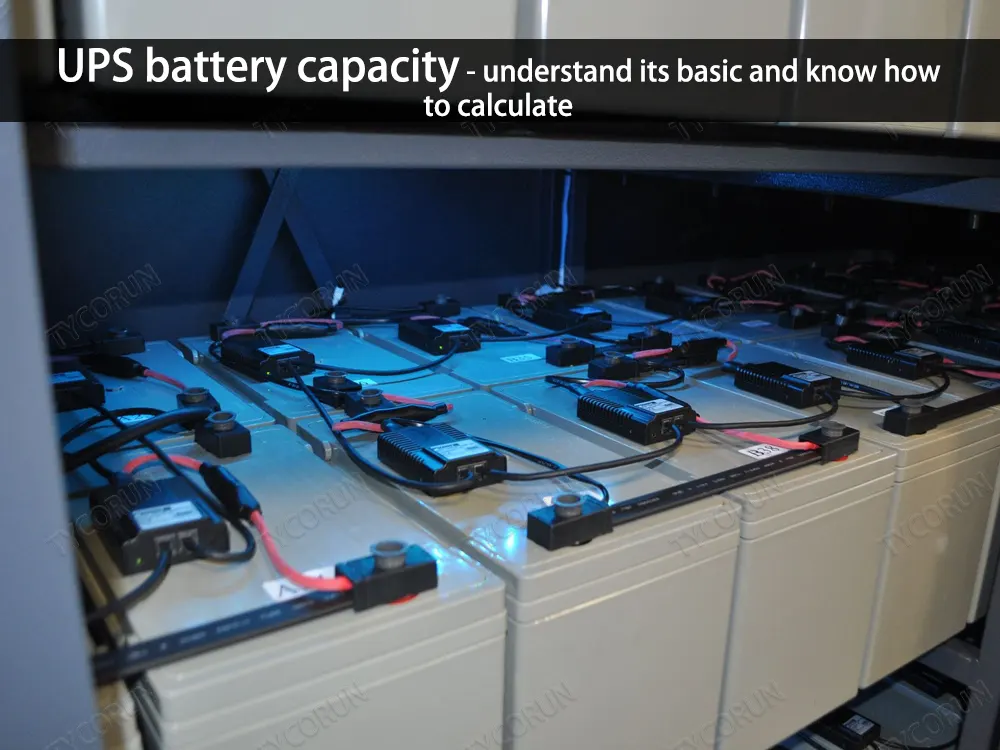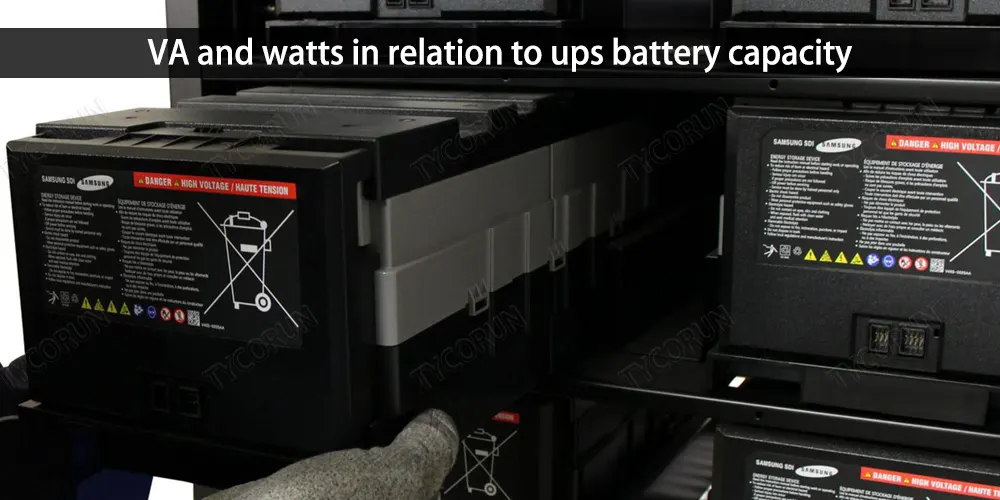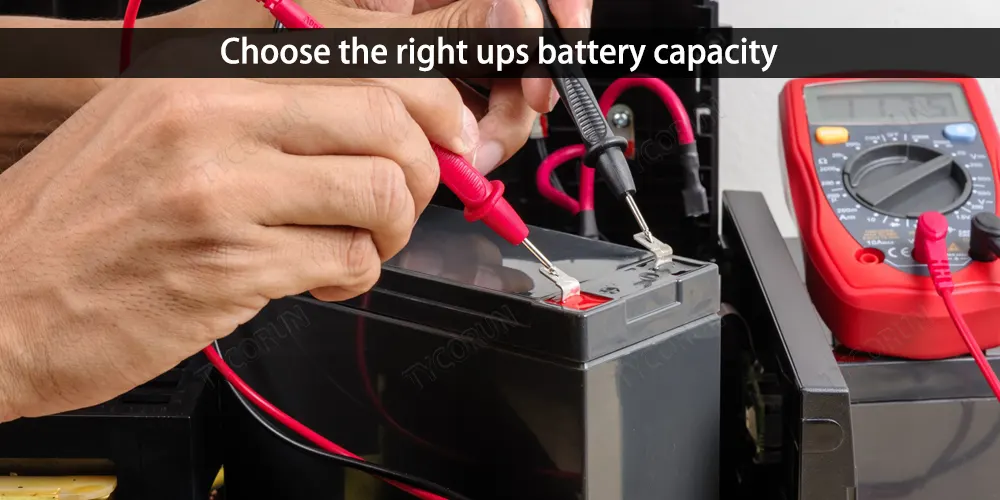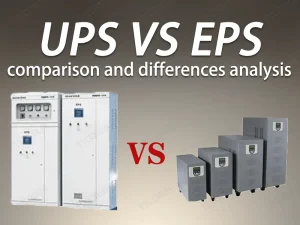Home » UPS battery » UPS battery capacity – understand its basic and know how to calculate
UPS battery capacity - understand its basic and know how to calculate
Note that keeping vital systems online during power outages depends on choosing the right UPS battery capacity. If you know how to calculate and optimize UPS battery capacity, you can choose the backup power needs wisely.
In this article, we’ll go further into the specs and capabilities of UPS batteries. We’ll show you how to calculate your UPS battery capacity depending on your needs.

What is ups battery capacity?
The capacity of an uninterruptible power supply (UPS) battery is the amount of energy that it can store and then release to the connected electronic devices when the power goes out.
An uninterruptible power supply (UPS) is a device that offers a secondary source of energy and shields sensitive electronics from power outages. A backup power source and surge protector for electronics like PCs, servers, routers, TVs, game consoles, and more is something you will find in this device.
The UPS battery capacity is often given in watt-hours (Wh) or ampere-hours (Ah), which measure how much power or current the battery can provide over a certain amount of time. UPS battery capacity is an important parameter to help you determine how well it will back up your device in case of a power outage.
Several variables affect the UPS battery capacity, including the battery’s type, size, age, ambient temperature, the number of charging and discharging cycles, and the total load of all connected devices. A wide range of battery kinds are used as a UPS battery, each with unique features and capabilities.
What is the maximum capacity of ups?
The maximum capacity of UPS depends on the type and size of the UPS system, as well as the power factor and the load power of the connected devices.
In most cases, the capacity of a UPS will be expressed in kilowatts (kW) or kilovolt-amperes (kVA); but, when it operates on alternating current (AC), as is increasingly common in data centers and buildings, kW and kVA may not be equivalent.
AC power has a power factor (PF), which is the ratio of real power (watts) to apparent power (volt-amperes). The load and UPS characteristics determine the PF value, which can be anything from zero (0) to one (1).
When the PF is high, the UPS is able to provide more of the actual power to the load, whereas when it is low, some of the apparent power is lost as reactive power.
The load power of the devices you want to connect to the UPS is a key factor in determining the maximum capacity of UPS that you need.
The watts (W) or kilowatts (kW) used by all connected devices constitute the load power. You can find the load power of each electronic device by checking its specifications or using a power meter.
For example, if you want to connect a PC, a router, a server, two switches, and a storage device to the UPS, and their load powers are 120 W, 30 W, 960 W, 280 W each, and 480 W respectively, then the total load power is 1870 W or 1.87 kW.
Selecting a UPS with a capacity greater than the load power is necessary to prevent the UPS from overloading. A good rule of thumb is to operate the UPS at about 80% of its actual rated capacity.
This means dividing the load power by 0.8 to get the minimum required UPS capacity in kW. For example, if the load power is 1.87 kW, then we need a UPS with a capacity of at least 1.87 / 0.8 = 2.34 kW.
In an actual sense, the maximum capacity of a UPS relies on a wide range of conditions and individual tastes. You can estimate the necessary UPS capacity by using calculations and recommendations based on our load power and power factor.
What is the difference between va and watts in relation to ups battery-capacity?
VA and watts are both ways to measure power, but they are not the same. The sum of a circuit’s voltage and current is called a volt-ampere, or VA for short, while wattage is the rate at which energy moves through or is used by a system.
Unlike watts, which measure actual power, VA measures just the apparent power (that is, how powerful something seems to be).
While a circuit’s maximum output power is known as its apparent power, not all of that power is necessarily put to good use. Working power, or real power, is what’s required to do things like turn on a computer or a fan.
The power factor is the ratio between these two powers, and it represents the efficiency with which a circuit consumes electricity. With a power factor of 1, all of the apparent power is transformed into usable energy, whereas with a lower value, part of the apparent power is lost as heat or noise.
Consider the UPS’s VA rating and the equipment’s wattage before deciding on a battery backup for electric devices. Power output is measured in watts, whereas load capacity is measured in volt-ampere-hours (VA). Uninterruptible power supply (UPS) should have a higher wattage rating than the sum of electric device’s power needs.
How do you calculate ups battery capacity?
You need the following data for the UPS battery capacity calculation:
● In watts (W), the total power required to operate the load.
● In volts (V), the battery’s direct current (DC) voltage.
● The load power factor (PF), the ratio of effective to apparent power
● UPS inverter efficiency (η), measured as the ratio of output power to input power
● The battery’s depth of discharge (DOD), or the maximum percentage by which it may be discharged before needing to be recharged
The formula for calculating the UPS battery capacity in Ah is:
UPS battery capacity (Ah) = {Load power (W) * Backup time (h)} ÷ {Battery voltage (V) * Power factor (PF) * Inverter efficiency (η) * Depth of discharge (DOD)}
For example, suppose you have a load that draws 100 W, a 12 V battery, a power factor of 0.8, an inverter efficiency of 0.9, and a depth of discharge of 0.5.
You want to know how much battery capacity you need to provide 2 hours of backup time. Using the formula above, you can calculate the UPS battery capacity as follows:
UPS battery capacity (Ah) = {100 * 2} ÷ {12 * 0.8 * 0.9 * 0.5} = 46.3
Therefore, you need a UPS battery with at least a capacity of 46.3 Ah to support your load for 2 hours.
Different types of ups battery capacity parameters
UPS battery capacity is affected by multiple variables like battery type, voltage, power factor, inverter efficiency, and depth of discharge.
When it comes to UPS systems, various battery types provide varying benefits. Let’s examine three popular UPS battery types and draw comparisons between them: valve-regulated lead-acid (VRLA), lithium-ion (Li-Ion), and nickel-cadmium (Ni-Cd).
| Parameter | VRLA | Li-ion | Ni-Cd |
|---|---|---|---|
| Energy density(Wh/L) | 60-70 | 150-300 | 50-150 |
| Battery life | 3 - 5 years | 5 - 8 years | 3 - 5 years |
| Battery weight | High | Low | High |
| Battery size | Large | Small | Large |
| Battery cost | Low | High | Medium |
| Battery maintenance | Moderate | Low | High |
Li-ion batteries provide the finest energy density, runtime, minimal maintenance, and space-saving, making them ideal for UPS systems. Li-ion batteries can provide up to three times longer life, higher efficiency, and higher depth of discharge than VRLA batteries.
In addition to being more versatile in terms of installation, Li-ion batteries can be recharged more quickly than VRLA or Ni-Cd batteries.
Therefore, UPS lithium battery will be one of the most cutting-edge and efficient battery types for UPS applications. Still, you must weigh their limits and constraints against those of other battery types before deciding.
What is the expected runtime of a ups battery based on its capacity?
The expected runtime of a UPS battery is the amount of time that the battery can provide backup power to the connected devices in case of a power outage. Multiple variables like the overall load, power factor, inverter efficiency, and depth of discharge affect how long your batteries will last.
The formula for calculating the expected runtime of a UPS battery based on its capacity in hours (h) is:
Expected runtime (h) = {Battery capacity (Ah) * Battery voltage (V) * Power factor (PF) * Inverter efficiency (η) * Depth of discharge (DOD)} ÷ {Total load (W)}
For example, suppose you have a UPS with a 12V lithium ion battery that has a capacity of 100 Ah. You want to connect a computer that consumes 120 W, a monitor that consumes 70 W, and a router that consumes 10 W to the UPS.
You also know that the power factor of your devices is 0.8, the inverter efficiency of UPS is 0.9, and the depth of discharge of your battery is 0.5. Using the formula above, you can calculate the expected runtime of your UPS battery as follows:
Expected Runtime = (100 * 12 * 0.8 * 0.9 * 0.5) ÷ (120+70+10) = 2.16 h
Therefore, with this load and configuration, you can expect your UPS battery to last about 2 hours, 9 minutes, and 36 seconds.
What are some common factors that can affect ups battery capacity?
● Ambient Temperature
A battery’s estimated capacity is based on a room temperature of 25°C (77°F). Any deviation from this optimal operating temperature might negatively affect the battery’s performance and decrease its lifespan.
● Cycling
The length and depth of the charging cycle affect how much a UPS battery capacity goes down. A lead acid battery has a finite lifespan, meaning that it will need to be replaced in short time. Also, this is why it is advisable to acquire lithium batteries since they have a longer discharge cycle.
● Battery Chemistry
If you don’t want to replace or care for battery as often, it’s a good idea to buy a battery with a premium chemistry that will last you longer.
Different types of batteries, like lead-acid, lithium-ion, and nickel-cadmium, have different qualities and benefits for UPS uses.
● Maintenance
UPS batteries need to be taken care of properly so that they work well and last as long as possible. Things like battery charger need to be checked regularly. At the same time, it is also necessary to check the battery status, and repair or replace it in time when it is found to be abnormal.
How do I choose the right ups battery capacity for my needs?
To choose the right UPS battery capacity for your needs, you need to think about two key things: the total amount of power your devices use and how long you want the backup to last.
The amount of energy all devices use, measured in watts (W) or volt-amps (VA), is their overall power usage. The preferred backup time is when you want the UPS to keep your devices running in hours (h) or minutes (min).
Once you know how much power you need and how long you want the backup to last, you can use a simple method to figure out how big the UPS battery capacity needs to be to help you choose the right one.
Here’s how it works:
UPS battery capacity (Wh) = Total power consumption (W) * Desired backup time (h)
For example, if you need a total of 200 W of power and want a backup time of 0.5 h (30 min), you can use the following formula to figure out how much power the UPS battery can hold:
UPS battery capacity (Wh) = 200 x 0.5 = 100
To power your devices for 30 minutes, you need a UPS battery with at least 100 Wh of power.
Conclusion
UPS battery capacity is how much energy it can store and provide to the associated load. You can calculate a UPS battery capacity and backup duration based on power consumption and device backup time.
Factors such as temperature, cycle, battery chemistry, usage, and maintenance might reduce the capacity of a UPS battery.
The efficiency and dependability of your equipment may depend on your choice of UPS battery capacity. Thus, learn how to get the right UPS battery capacity in the article and contact us to get an ideal UPS battery.
FAQs
You can connect multiple UPS batteries for more capacity, but they must be connected in parallel, not in series. In this manner, the battery pack's voltage is the same as the voltage of a single battery, but the square of the number of batteries increases the pack's capacity (in amp-hours or watt-hours). However, ensure your UPS can manage the additional load and charge the batteries appropriately.
High or low ambient temperature, frequent cycling, incorrect float voltage, mismatched battery type, size, or age, and inadequate maintenance are all potential causes of UPS battery failure.
There are benefits and drawbacks to using a UPS battery capacity that exceeds or falls short of your electronic device's needs. More backup time is available with a UPS with a larger battery than your device requires, but this comes at a higher price. A UPS with less battery capacity than your device needs will be cheaper, smaller, and lighter, but it will also have less backup time and may not be able to support your device during a power loss.




























